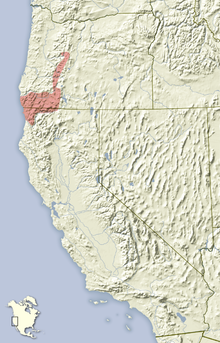Siskiyou chipmunk
| Siskiyou chipmunk | ||||||||||||
|---|---|---|---|---|---|---|---|---|---|---|---|---|
| Systematics | ||||||||||||
|
||||||||||||
| Scientific name | ||||||||||||
| Tamias siskiyou | ||||||||||||
| ( AH Howell , 1922) |
The Siskiyou chipmunk ( Tamias siskiyou , Syn . : Neotamias siskiyou ) is a type of squirrel from the genus of the chipmunk ( Tamias ). It occurs only in the Siskiyou Mountains in the American states of Oregon and California .
features
The Siskiyou chipmunk reaches an average head-trunk length of about 14.4 to 14.7 centimeters, the tail length is about 10.5 centimeters and the weight is about 75 grams. It is accordingly a relatively large chipmunk. The back color is red to cinnamon brown and, like other species of the genus, there are several dark back stripes on the back, which are separated by lighter stripes and delimited from the sides of the body. In terms of color, it is very similar to the Allen chipmunk ( Tamias senex ) and the yellow-cheeked chipmunk ( Tamias ochrogenys ), from which it can only be safely distinguished by comparing the penis bones (baculum) or the clitoris bones (Baubellum).
distribution
The Siskiyou chipmunk is only found in the Siskiyou Mountains in the American states of Oregon and California . The distribution area extends from central Oregon south to northern California.
Way of life
Siskiyou chipmunks live in coastal areas, particularly in forests of the coast sequoia ( Sequoia sempervirens ), as well as Douglas fir ( Pseudotsuga menziesii ), the West American hemlock ( Tsuga heterophylla ) and Lawson ( Chamaecyparis lawsoniana ) and with oak ( Quercus ) and maples ( Acer ). Inland, the animals are found mainly in populations of the sugar pine ( Pinus lambertiana ), the Jeffrey pine ( Pinus jeffreyi ) and the Douglas fir. They are more common in regions with more biomass on the ground, as well as away from river areas at higher altitudes.
The species is diurnal and lives on the ground as well as climbing in the trees. The animals feed mainly herbivorous of seeds and fruits of grasses, bushes and trees, added other parts of plants and living underground fungi and insects and small vertebrates as a supplementary food.
The mating season for this species is in early to mid April. The gestation period is about 28 days and the young are born in May. The litter consists of three to six young animals on average. Very limited information is available on predators and parasites.
Systematics
The Siskiyou chipmunk is classified as a separate species within the genus of chipmunks ( Tamias ), which consists of 25 species. The first scientific description comes from the American naturalist Arthur Holmes Howell from 1922, who described it as Eutamias siskiyou on the basis of individuals from the summit of White Mountain in the Siskiyou Mountains of California at a height of 1829 meters. Within the chipmunk group, the Siskiyou chipmunk, along with most of the other species, is assigned to the subgenus Neotamias , which is also discussed as an independent genus. Sometimes it was considered a subspecies of the Townsend chipmunk ( Tamias townsendii ).
Within the species, together with the nominate form, two subspecies are distinguished:
- Tamias siskiyou siskiyou : nominated form; occurs in the coastal area up to about 32 kilometers inland. The coastal shape is darker yellow-brown and the skull is larger.
- Tamias siskiyou humboldti : lives off the coast in inland Oregon and California. The shape has gray washouts and gray stripes on the back.
Status, threat and protection
The Siskiyou chipmunk is classified by the International Union for Conservation of Nature and Natural Resources (IUCN) as "Least Concern" (LC). This is justified by the relatively large distribution area of more than 20,000 km 2 and the regular occurrence; there are no known risks to the existence of the plant.
supporting documents
- ↑ a b c d e f Richard W. Thorington Jr. , John L. Koprowski, Michael A. Steele: Squirrels of the World. Johns Hopkins University Press, Baltimore MD 2012, ISBN 978-1-4214-0469-1 , pp. 340 .
- ^ A b Neotamias siskiyou in the Red List of Threatened Species of the IUCN 2015.4. Posted by: AV Linzey, NatureServe (G. Hammerson), 2008. Retrieved June 27, 2016.
- ↑ a b c Tamias (Neotamias) siskiyou In: Don E. Wilson , DeeAnn M. Reeder (Ed.): Mammal Species of the World. A taxonomic and geographic Reference. 2 volumes. 3. Edition. Johns Hopkins University Press, Baltimore MD 2005, ISBN 0-8018-8221-4 .
- ↑ Bruce D. Patterson, Ryan W. Norris: Towards a uniform nomenclature for ground squirrels: the status of the Holarctic chipmunks. Mammalia 80 (3), May 2016; Pp. 241-251 doi : 10.1515 / mammalia-2015-0004
literature
- Richard W. Thorington Jr. , John L. Koprowski, Michael A. Steele: Squirrels of the World. Johns Hopkins University Press, Baltimore MD 2012, ISBN 978-1-4214-0469-1 , pp. 340 .
Web links
- Neotamias siskiyou inthe IUCN Red List of Threatened Species 2015.4. Posted by: AV Linzey , NatureServe (G. Hammerson), 2008. Retrieved June 27, 2016.
